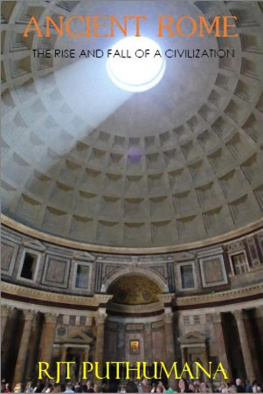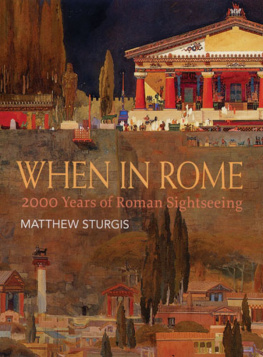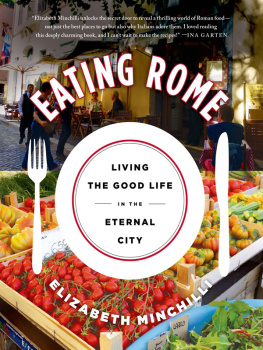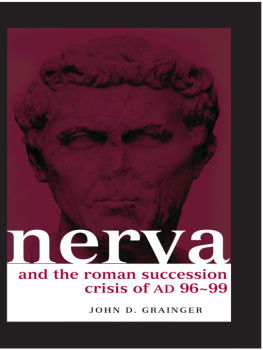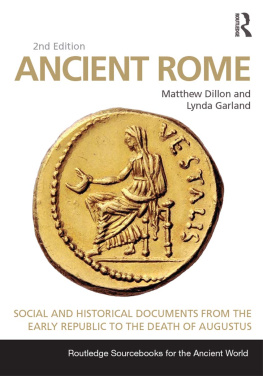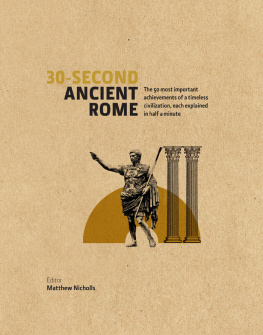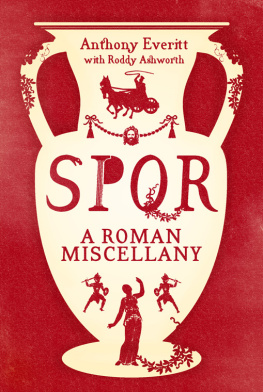Matthew Sturgis - When in Rome: 2000 Years of Roman Sightseeing
Here you can read online Matthew Sturgis - When in Rome: 2000 Years of Roman Sightseeing full text of the book (entire story) in english for free. Download pdf and epub, get meaning, cover and reviews about this ebook. year: 2011, publisher: MBI, genre: Religion. Description of the work, (preface) as well as reviews are available. Best literature library LitArk.com created for fans of good reading and offers a wide selection of genres:
Romance novel
Science fiction
Adventure
Detective
Science
History
Home and family
Prose
Art
Politics
Computer
Non-fiction
Religion
Business
Children
Humor
Choose a favorite category and find really read worthwhile books. Enjoy immersion in the world of imagination, feel the emotions of the characters or learn something new for yourself, make an fascinating discovery.

- Book:When in Rome: 2000 Years of Roman Sightseeing
- Author:
- Publisher:MBI
- Genre:
- Year:2011
- Rating:5 / 5
- Favourites:Add to favourites
- Your mark:
- 100
- 1
- 2
- 3
- 4
- 5
When in Rome: 2000 Years of Roman Sightseeing: summary, description and annotation
We offer to read an annotation, description, summary or preface (depends on what the author of the book "When in Rome: 2000 Years of Roman Sightseeing" wrote himself). If you haven't found the necessary information about the book — write in the comments, we will try to find it.
When in Rome: 2000 Years of Roman Sightseeing — read online for free the complete book (whole text) full work
Below is the text of the book, divided by pages. System saving the place of the last page read, allows you to conveniently read the book "When in Rome: 2000 Years of Roman Sightseeing" online for free, without having to search again every time where you left off. Put a bookmark, and you can go to the page where you finished reading at any time.
Font size:
Interval:
Bookmark:


4 Torriano Mews
Torriano Avenue
London NW5 2RZ
www.franceslincoln.com
2000 Years of Roman Sightseeing
Copyright Frances Lincoln Limited 2011
Text copyright Matthew Sturgis 2011
Drawings copyright Natalie Turner 2011
eBook ISBN 978-1-7810-1020-4
BACK ENDPAPERS G.B. Nollis plan of Rome in 1748
FRONTISPIECE The pointing hand of Constantine: a fragment of the colossal statue in the courtyard of the Palazzo dei Conservatori
Lavinia
and
La Famiglia Farrelly
W HEN I FIRST went to Rome in 1980, in the summer before going to university, I took with me a much-battered old Baedeker, borrowed from my grandparents bookshelves. I liked the fact that it didnt look like a guidebook, at least not by the standards of 1980. Then every visitor to Italy clutched either the long, tall, green-bound Michelin guide, or the bright blue and white Benns Blue Guide, or perhaps the garish outsized Europe on $20 a Day. These were books that proclaimed their presence. They were too big to fit in a jacket pocket, and although their forms were already distinctive enough, their titles were emblazoned in large letters upon their shiny covers. By contrast the 1904 edition of Baedekers Central Italy, discreet and blockish, in its faded red boards, was wonderfully anonymous. It looked like a missal. And it allowed me to indulge my affected youthful idea of not being taken for a tourist (which, of course, was exactly what I was).
The book might have been old but Rome, as I reasoned, was older: much older. The Colosseum, the Sistine Chapel, the Pantheon and the Spanish Steps had all been created well before 1904. The ticket prices quoted in the text would be out of date, and the museum opening times might be wrong, but this, as I knew, could often be the case even with modern guidebooks. What was important was the information about the ancient monuments and Renaissance artworks, and this must still be correct, as true in 1980 as it had been in 1904. And at the level of mere facts and dates this proved to be pretty much the case. But, as I learnt, there is rather more to discovering a city than mere facts and dates.
Walking one day between the Pantheon and the Piazza Navona I encountered the striking Renaissance faade of S. Luigi dei Francesi, the national church of the French. My Baedeker encouraged me to investigate. The church contained, besides a monument to the French soldiers who fell at the siege of Rome in 1849, a noted artistic masterpiece, a starred item worthy of special attention and admiration: Right Aisle, 2nd Chapel: *Frescoes from the life of St. Cecilia, one of the most admirable works of Domenichino.
The name Domenichino registered only very faintly. I had perhaps heard of him, but certainly I had no very clear idea of what his art might look like. Nevertheless I went in and dutifully peered into the gloomy ill-lit recesses of the second chapel on the right. I could dimly make out a large wall-painting of a girl in a turban expiring elegantly in a monumental and crowded bathroom, with opposite a boisterous jumble sale scene of the young saint giving away all her worldly possessions to the poor. They were all right, I suppose, but rather posed and artificial; very different from the staid, potent, serene images I had been looking at over the previous month in Florence, Siena, and Arezzo paintings by Giotto, Fra Angelico, Botticelli and Piero della Francesca.
As I stood, quite alone, leaning over the chapels marble balustrade, I became aware of a muted hubbub elsewhere in the church. There was the murmur of excited voices, the hurry of footsteps over the marble floor, the drop of a coin into a machine and the sudden flare of illumination. All this excited activity, I discovered, was coming from a chapel at the far end of the church, to the left of the altar. A tourist throng was gathering there. But to look at what?
I consulted my Baedeker. It gave no clue at all. Besides the starred Domenichino frescoes, the only other artworks the book considered worthy of mention were a picture of St Cecilia by Guido Reni and Francesco Bassanos fine Assumption, placed over the high altar.
Approaching the little crowd I found them clutching their various modern guidebooks all admiring a set of three arresting frescoes: rakingly lit scenes of human drama and violence. In the otherwise tenebrous church, a coin-operated lighting system gave a clear sight of the paintings. There were postcards for sale. And a notice proclaimed that here were Caravaggios frescoes of the life of St Matthew. Caravaggio I had heard of. I could recall his painting of The Supper at Emmaus from the National Gallery in London. And the pictures of St Matthew had an immediate appeal, a sense of almost cinematic intensity and realism. Peering over the shoulders of a French couple I noticed that their Michelin Green Guide had awarded the pictures the ultimate accolade of three asterisks. Here was a trio of pictures to view which was not merely worth a detour but worth a journey.
Caravaggios frescoes had become one of the star attractions of Rome, and yet seventy-five years before, they hadnt even rated a mention in the most impressively thorough guide to the citys art treasures.
At first this struck me as no more than an interesting but isolated quirk. On subsequent Roman holidays, however, I began to realize that it fitted into a much broader pattern.
Rome, I came to appreciate, is unique in that it has been a tourist destination for over two thousand years. Since the second century BC people have travelled to Rome deliberately to look at its monuments and its treasures. Almost all these visitors, it seems, have been amazed and impressed by what they have found. Yet their notions of what was worth seeing what was amazing and impressive and why have changed almost with each generation, certainly with every era. This, of course, is partly because Rome itself has changed with the ages; old monuments were continually being swept away and new ones were continually being erected. But there have also been regular and often abrupt changes in the tastes, the interests and the expectations of those who visit the city. The eclipse of Domenichino by Caravaggio during the course of the twentieth century was, it transpired, only one instance among many.
Font size:
Interval:
Bookmark:
Similar books «When in Rome: 2000 Years of Roman Sightseeing»
Look at similar books to When in Rome: 2000 Years of Roman Sightseeing. We have selected literature similar in name and meaning in the hope of providing readers with more options to find new, interesting, not yet read works.
Discussion, reviews of the book When in Rome: 2000 Years of Roman Sightseeing and just readers' own opinions. Leave your comments, write what you think about the work, its meaning or the main characters. Specify what exactly you liked and what you didn't like, and why you think so.



